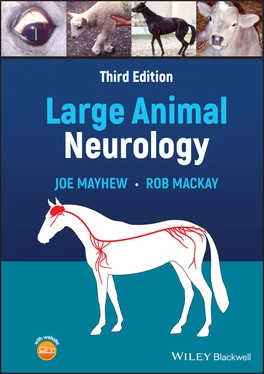36 35 Charalambous M, Volk HA, Tipold A, et al. Comparison of intranasal versus intravenous midazolam for management of status epilepticus in dogs: a multi‐center randomized parallel group clinical study. J Vet Intern Med 2019; 33(6): 2709–2717.
37 36 Duran SH, Ravis WR, Pedersoli WM and Schumacher J. Pharmacokinetics of phenobarbital in the horse. Am J Vet Res 1987; 48(5): 807–810.
38 37 Knox DA, Ravis WR, Pedersoli WM, et al. Pharmacokinetics of phenobarbital in horses after single and repeated oral administration of the drug. Am J Vet Res 1992; 53(5): 706–710.
39 38 Ravis WR, Duran SH, Pedersoli WM and Schumacher J. A pharmacokinetic study of phenobarbital in mature horses after oral dosing. J Vet Pharmacol Ther 1987; 10(4): 283–289.
40 39 Reimer JM and Sweeney RW. Pharmacokinetics of phenobarbital after repeated oral administration in normal horses. J Vet Pharmacol Ther 1992; 15(3): 301–304.
41 40 Gamble KC, Lacasse C, Way SI and Boothe DM. Management of idiopathic epilepsy in a female Grevy's zebra (Equus grevyi) with potassium bromide and therapeutic drug monitoring. Proc Intl Conf Dis Zoo Wld Anim, Beekse Bergen, The Netherlands. May 2009; 59–64.
42 41 Raidal SL and Edwards S. Pharmacokinetics of potassium bromide in adult horses. Aust Vet J 2005; 83(7): 425–430.
43 42 Guan F, Uboh CE, Soma LR, et al. Quantification of phenytoin and its metabolites in equine plasma and urine using high‐performance liquid chromatography. J Chromatogr B Biomed Sci Appl 2000; 746(2): 209–218.
44 43 Kowalczyk DF and Beech J. Pharmacokinetics of phenytoin (diphenylhydantoin) in horses. J Vet Pharmacol Ther 1983; 6(2): 133–140.
45 44 Soma LR, Uboh CE, Guan F, et al. Disposition, elimination, and bioavailability of phenytoin and its major metabolite in horses. Am J Vet Res 2001; 62(4): 483–489
46 45 Quast TA, Combs MD and Edwards SH. Pharmacokinetics of bromide in adult sheep following oral and intravenous administration. Aust Vet J 2015; 93(1–2): 20–25.
47 46 Spehar AM, Hill MR, Mayhew IG and Hendeles L. Preliminary study on the pharmacokinetics of phenobarbital in the neonatal foal. Equine Vet J 1984; 16(4): 368–371
48 47 MacDonald KD, Hart KA, Davis JL, Berghaus LJ and Giguere S. Pharmacokinetics of the anticonvulsant levetiracetam in neonatal foals. Equine Vet J 2018; 50(4): 532–536.
49 48 Davis JL, Posner LP and Elce Y. Gabapentin for the treatment of neuropathic pain in a pregnant horse. J Am Vet Med Assoc 2007; 231(5): 755–758.
50 49 Mullen KR, Schwark W and Divers TJ. Pharmacokinetics of single‐dose intragastric and intravenous pregabalin administration in clinically normal horses. Am J Vet Res 2013; 74(7): 1043–1048.
51 50 Rundfeldt C, Tipold A and Loscher W. Efficacy, safety, and tolerability of imepitoin in dogs with newly diagnosed epilepsy in a randomized controlled clinical study with long‐term follow up. BMC Vet Res 2015; 11: 228.
52 51 Podell M, Volk HA, Berendt M, et al. 2015 ACVIM Small Animal Consensus Statement on Seizure Management in Dogs. J Vet Intern Med 2016; 30(2): 477–490.
53 52 Porter RJ and Rogawski MA. Antiseisure drugs. In Basic & Clinical Pharmacology, Katzung BG, Masters SB, Trevor AJ, Eds. 14th ed. McGraw‐Hill Education. 2018; 409–438.
7 Sleep and acute collapse disorders

The role of sleep in mammalian biology is somewhat of an enigma. 1Adult herbivores spend a substantial proportion of time foraging, and only a few hours daily are spent in stages of sleep, a small proportion of which is rapid eye movement (REM) sleep with accompanying somatic hypotonia or atonia and recumbency. 1–3For adult cattle and horses, this amounts to 3–5 h per day in sleep states and about 0.5 h per day in REM sleep. 3–6Some horses appear to be able to perform REM sleep while standing 2and to tolerate weeks of being unable to lie down to sleep, whereas others experience great difficulties in being cross‐tied for several days. The latter appear to go into a deep sleep state but stagger as not being able to remain upright, and some can injure themselves. Thus, the concept of sleep deprivation in horses may well be an individual phenomenon. 3,7
Without observing episodes, it can be difficult to distinguish seizures from normal and abnormal episodes of sleep and from cardiovascular collapse or syncope in otherwise perfectly healthy patients. The last of these show multiple episodes of collapse but with apparent normalcy between is incredibly rare in our experience, but seizures and sleep disorders can be quite distinguishable if observed. In this regard, 24‐h video monitoring and recording can be useful to capture suspected episodes of sleep and seizures when they are not overt. 8However, intermittent paralysis or cataplexy can pose as syncope, epileptic seizures (particularly pseudocataplexy or atonic seizures), hyperekplexia, and vestibular drop attacks. 9
In the context of sudden and unexpected collapse, there are many systemic issues that can mediate an abrupt loss of body support, 10but the majority result in other progressive signs such as weakness and obtundation or are associated with other factors such as trauma, diarrhea, or drug usage. 11In about half the cases of episodic collapse, it may be possible to arrive at a final diagnosis with most having signs other than collapse being evident. Such diagnoses include cardiac arrhythmia, right‐sided heart failure, hypoglycemia, neurocardiogenic syncope, and exercise‐induced pulmonary hemorrhage. For most other cases, there will be a strong suspicion of epilepsy ( Chapter 6) and sleep disorders. 12
Sleep disorders in humans 313–15can be categorized into many groupings, but these usually include narcolepsy with cataplexy (narcolepsy type‐1, NT‐1) ( Figure 7.1), narcolepsy without cataplexy (NT‐2), and idiopathic hypersomnia (see Chapter 31for further readings on narcolepsy in large animals). 316–23Narcolepsy occurs in 0.02–0.15% of the population, and patients typically demonstrate excessive diurnal sleep, flaccid paralysis with somatic areflexia that constitutes cataplexy, sleep paralysis, sleep‐onset hallucinations, and nocturnal disrupted sleep. Strict EEG and EOG criteria, including the early onset of rapid eye movement at the beginning instead of the middle of a sleep cycle, are in place for confirming the diagnosis and for distinguishing narcolepsy with cataplexy from narcolepsy without cataplexy and from idiopathic hypersomnia. A familial form of narcolepsy with cataplexy occurs in dogs and humans, and in the latter it is strongly associated with the genetic allele HLA‐DQβ1*0602. An autoimmune basis to at least some forms of narcolepsy thus seems likely. 13Narcolepsy without cataplexy shares the same electrophysiological abnormalities and associated signs, but there is no demonstrable cataplexy. Purely excessive daytime sleep attacks, also referred to as unwanted siestas (a well‐appreciated term!), occur in idiopathic hypersomnia.

Figure 7.1 Familial narcolepsy with cataplexy as seen in these two ponies is uncommon compared to other forms of sleep disorders in horses. These ponies would, spontaneously and particularly with pleasurable stimuli such as grooming, feeding, and playing (A), rapidly become somnolent, stagger or sway, and fall passively to the ground in a cataplectic state (B) with no spinal reflexes demonstrable, where they would remain until they slowly woke up after a minute to an hour or so.
Читать дальше














